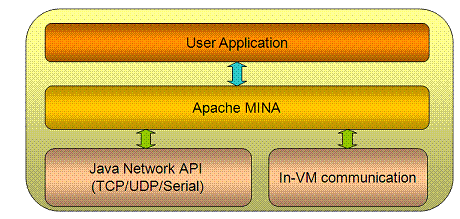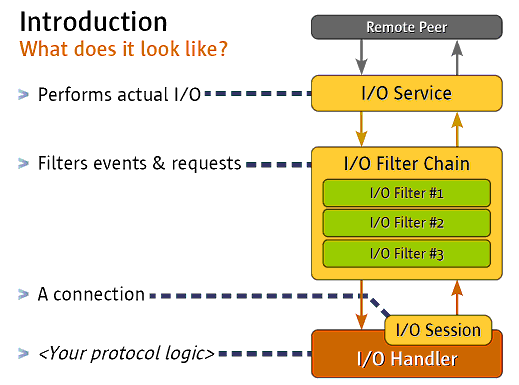 2009年6月29日
2009年6月29日
mina是何物?
Mina是一個用于開發(fā)高性能和高可用性的網(wǎng)絡應用程序基礎架構(gòu),它封裝了底層的I/O和線程并發(fā)等復雜工作。
Mina主要是基于java NIO類庫開發(fā);采用非阻塞方式的異步傳輸、事件驅(qū)動、批量數(shù)據(jù)傳輸;支持TCP、UDP網(wǎng)絡協(xié)議
首先從服務器端啟動NioSocketAcceptor對象進行分析。
1、實例化DefaultSocketSessionConfig會話配置器和異步傳輸NioProcessor處理器
2、實例化AbstractPollingIoAcceptor構(gòu)造器同時實例化SimpleIoProcessorPool處理器池
--〉在SimpleProcessorPool中初始化執(zhí)行器<線程池>,然后初始化一個IoProcessor對象數(shù)組,長度為3,最后將處理器對象放入到IoProcessor數(shù)組中
--〉處理化傳輸帶元數(shù)據(jù)
--〉初始化服務監(jiān)視器
--〉初始化異常監(jiān)視器
3、初始化過濾鏈
4、初始化選擇器
架構(gòu)介紹
應用結(jié)構(gòu)圖
深入分析結(jié)構(gòu)圖
mina的基本應用可以分為3層:
1、I/O Serivce:實際執(zhí)行I/O層
2、I/OFilter chain:數(shù)據(jù)過濾和轉(zhuǎn)換層,主要是把字節(jié)轉(zhuǎn)換為需要的數(shù)據(jù)格式或者反過來處理
3、I/OHandler:業(yè)務處理層
創(chuàng)建Mina應用分為3部分:
1、創(chuàng)建I/O 2、創(chuàng)建過濾鏈
3、創(chuàng)建I/O業(yè)務處理
Dojo 是一個用javascript語言實現(xiàn)的開源DHTML工具包。它是在幾個項目捐助基礎上建立起來的(nWidgets, Burstlib, f(m)), 這也是為什么叫它a \"unified\" toolkit的原因。Dojo的目標是解決開發(fā)DHTML應用程序遇到的那些,長期存在 、歷史問題。historical problems with DHTML 跨瀏覽器問題。Dojo讓你更容易 使web頁面具有動態(tài)能力,或在任何穩(wěn)健的支持javascript語言的環(huán)境中發(fā)揮作用。
a、利用dojo提供的組件,你可以提升你的web應用程序可用性、交互能力以及功能上的提高;
b、你也可以 更容易的建立degradeable user interfaces ??,dojo提供小巧的 widgets ,animate transitions;
c、利用它的低級APIs和可兼容的代碼,寫出輕便的、單一風格(復雜)的javascript代碼,Dojo的 event system, I/O APIs, and generic language enhancement form the basis of a powerful programming environment.
d、通過Dojo提供的工具,你可以為你的代碼寫命令行式的單元測試代碼。
e、the Dojo package system使你自己的代碼更容易維護,偶合性更低。
Dojo通過很少的代碼完成了以上的功能。(以后可能我詳細說說dojo的package system ,只需要三個js文件)。當你寫腳本時,只需要包含很少的js文件(大小)。也可以選擇的(包含)下載dojo提供的龐大的功能。Dojo provides MultiplePointsOfEntry, InterpreterIndependence, ForwardLookingAPIs, and focuses on ReducingBarriersToAdoption.
dojo試圖建立一種新的標簽語言DojoML。目標是,在DojoML和javascript腳本語言不變的情況下,用不同的render方式展示數(shù)據(jù), Renderings may be made available in several rendering contexts (such as SVG, or perhaps even the desktop or Flash)。(比較美好啊)更進一步,the DojoML 剖析器可以接受html和svg為輸入,容易的建立DegradeableResponsiveApplications。
第一部分 安裝
第一個小節(jié) 怎么安裝Dojo Toolkit
Dojo在磁盤上只是一堆文件,它不需要特殊的設置,它可以通過以下三種途徑獲得:
1、可以從google的內(nèi)容分布網(wǎng)絡獲得
加載的方法可以參考http://code.google.com/intl/zh-CN/apis/ajaxlibs/documentation/index.html#dojo
2、.在你自己的服務器上使用Dojo
a、下載最新的dojo包,地址:http://dojotoolkit.org/downloads;目前最新的包為1.3.1
b、解壓下載的壓縮文件
--dojo-release-1.3.1-src
----dijit
----dojo
----dojox
----util
c、可以通過D:\Apache-Source\dojo\1.3.1\dojo-release-1.3.1-src\dojo-release-1.3.1-src\dijit\themes\themeTester.html 這樣的路徑來查看相關的JS例子
3、每日構(gòu)建代碼
你可以通過SVN地址獲得
For instance, Dojo Core repository is:
http://svn.dojotoolkit.org/src/dojo/trunk
There are two versions of this view: anonymous and committer.
For users (readonly):
http://svn.dojotoolkit.org/src/view/anon/all/trunk
For committers (read/write):
https://svn.dojotoolkit.org/src/view/committer/all/trunk
第二部分 Ajax
第一個小節(jié) ajax
a、ajax and Dojo
1)XHR選項
例子:
// post some data, ignore the response: dojo.xhrPost({ form: "someFormId", // read the url: from the action="" of the <form> timeout: 3000, // give up after 3 seconds content: { part:"one", another:"part" } // creates ?part=one&another=part with GET, Sent as POST data when using xhrPost }); // get some data, convert to JSON dojo.xhrGet({ url:"data.json", handleAs:"json", load: function(data){ for(var i in data){ console.log("key", i, "value", data[i]); } } });
2)XHR回調(diào)
有三種方法可以附加到XHR選擇對象,以確定當數(shù)據(jù)回調(diào)時該怎么做。
CatalogFacade對象在服務器啟動時被實例化,然后將實例化的CatalogFacade對象放置到ServletContext環(huán)境中,這樣可以直接從ServletContext環(huán)境中取得CatalogFacade對象進行相關數(shù)據(jù)方法的調(diào)用。
index.jsp中涉足到一個js框架DOJO,這個需要進一步的學習。
對數(shù)據(jù)的增、刪、改、查主要用到了JPA來處理。



